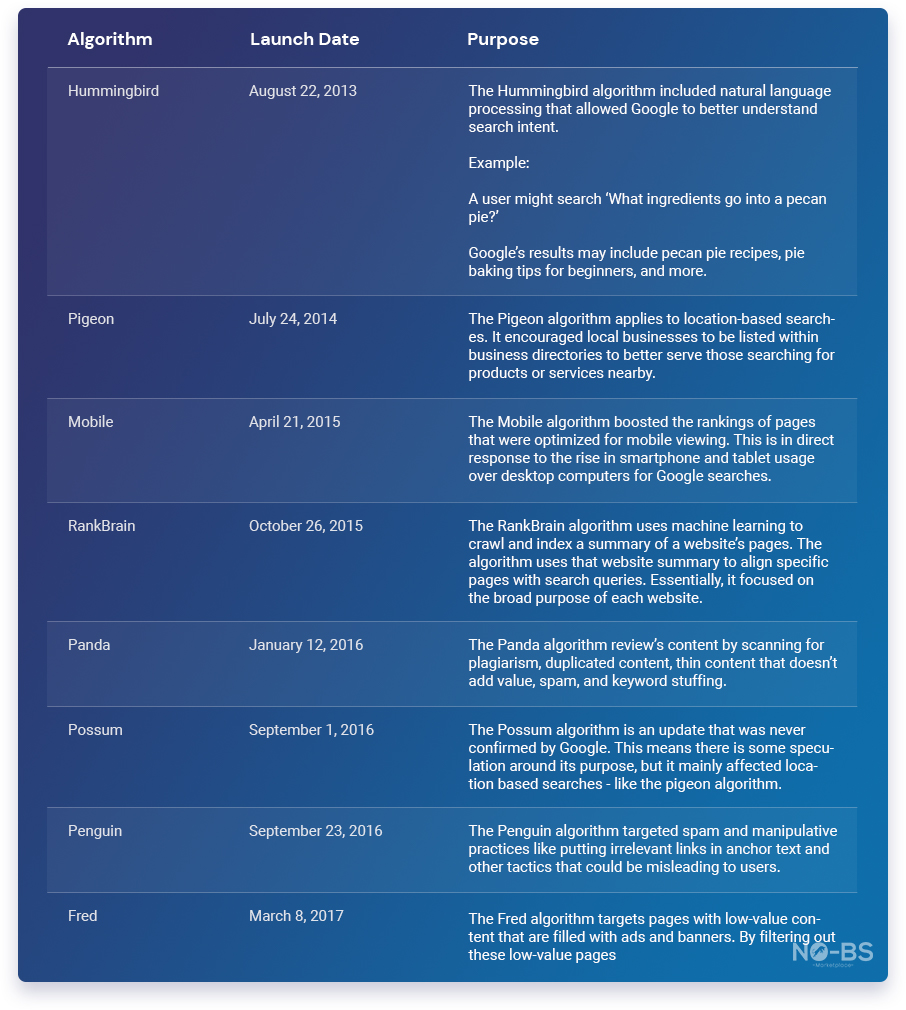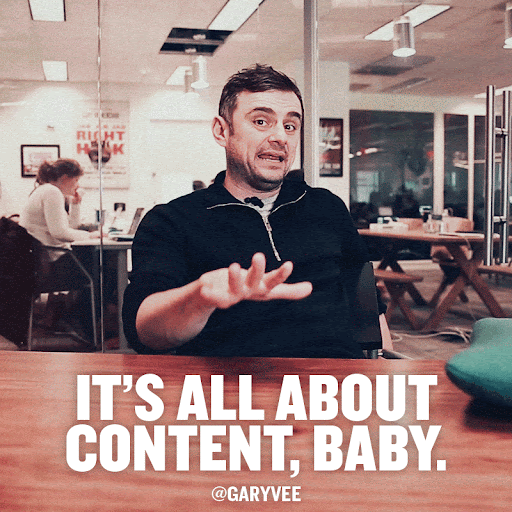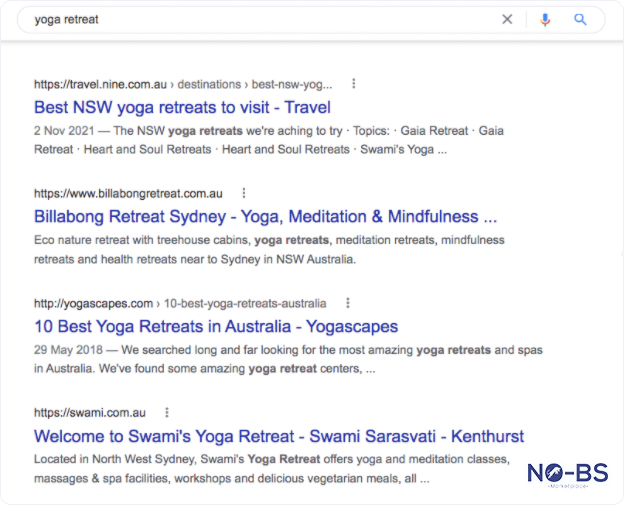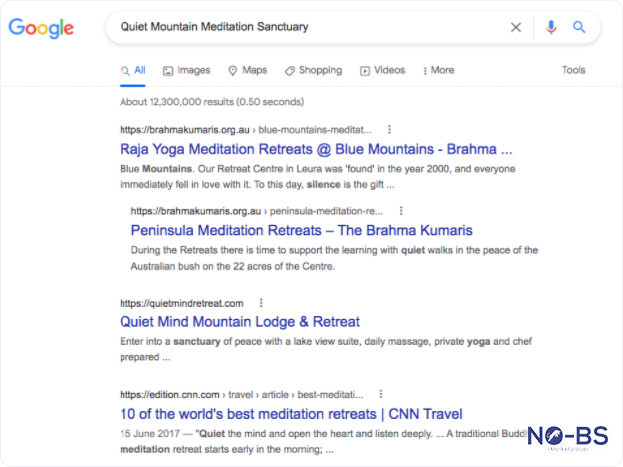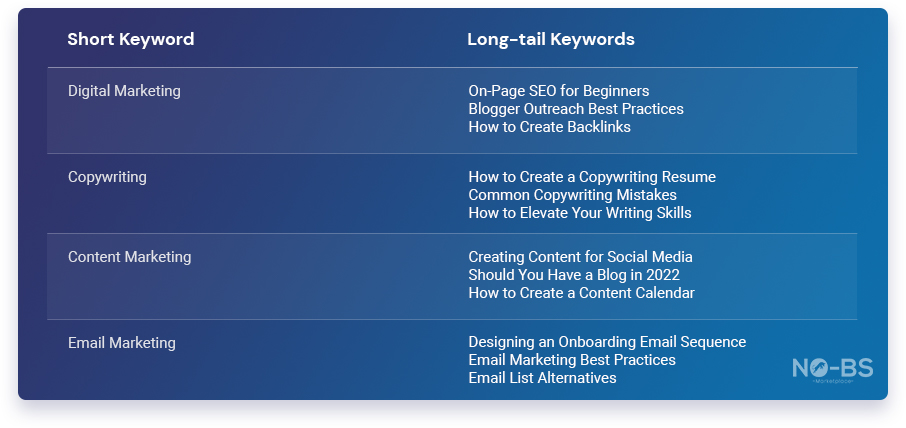Understand Google’s Algorithms to Create High-Quality Content
-
Aaron Gray
- Blogs
-
November 19 , 2021
-
10 min read
Creating high-quality content is essential if you want to stand out among others in Search Engine Page Results (SERPs). The best way to provide unique value and improve your ranking in SERPs is through creating useful, engaging, and optimized content.
In recent years, Google has made several updates to how it compiles, organizes, and displays information to users. Let’s talk more about Google’s algorithms, the difference between good content and optimized content, and how you can start creating optimized content right now.
The Short History of Google’s Algorithms
Google is continuously updating its algorithm to optimize the user experience. When people open Google or any search engine, they’re looking for something and they want to find the thing they’re looking for quickly and easily.
Google’s algorithms compile and sort all of the information on the internet in a way that allows all users everywhere to get the best fit for their search query within the first 2 pages. Below is a comprehensive overview of Google’s most important algorithm updates.
May the Best Content Rank
It all starts with great content.
Google’s algorithm updates have all focused on 1 thing: getting people in front of content that best meets their needs quickly and easily. But what exactly is content?
Content is a broad term that can be broken up into several categories: Web Pages, Blog Posts, Videos, Podcasts, Social Media, Email, Search Engine Results, etc.
So, content is anything created and shared under your brand. The best content is engaging, useful, easy to read, and most importantly – provides value. When creating high-quality content, it’s important to keep the end-user in mind. Here are some tips to consider while creating content:
- Be clear and concise
- Add images and negative space to break up text
- Use your unique voice
- Have fun with it
Great Content vs Optimized Content
Sure, it all starts with great content, but providing quality content will only get you so far. People need to know you’re producing this amazing content and the only way they’ll know is if you increase traffic to your site.
Website traffic measures the number of users who visit your site in a given period. The easiest way to increase the number of visits your website gets is to improve your ranking on search engine results pages or SERPs. Millions of Google searches happen every hour – that’s a lot of traffic! How do you capitalize on the existing wealth of users on Google and other search engines? With optimized content.
Optimizing your content improves your ability to attract your ideal user and drive them to your site over your competitors. Let’s walk through how you can do this in 4 simple steps:
- Pick a Lane
- Stay in Your Lane
- Internal Linking
- Fine Tuning Technical SEO
Check out our wholesale SEO packages to learn how we can support your team.
- Pick a Lane
Think of search engines as one big highway for search traffic. All the websites that show up on SERPs are the vehicles on the highway. People searching are looking for a vehicle that can take them to information, products, or services that they need.
Vehicles that pick a niche, or a lane, are like big busses with reliable schedules that users trust. Vehicles that constantly switch lanes and explore a wide variety of things have less authority and trust from users, but they are easy to find.
Okay, enough with the highway analogy for now. What I’m saying is, if you want to increase visits to your website, it’s best to pick a lane, aka a niche. When people land on your site, they want to easily understand what your brand is, what you offer, and how your offerings can help them.
To determine your niche, define the broad topic or topics you want to rank high for. You can do this through audience research and reflection.
Research
- Who is your target audience? To get a clear picture, it may be helpful to develop client personas. A client persona is a fake customer that models the characteristics of someone in your target audience.
- What are they searching for and who else offers what they’re searching for? This helps you see what search terms have high traffic and which competitors are already standing out.
Reflection
- How does the research align with your brand? So, now that you know more about who your target audience is and what they’re looking for, do you already have content that can help? Or, do you have content that just doesn’t fit?
- What are some broad keywords you can start with? Start broad and then get more specific. Keeping a broad approach is great for topic ideation. Then begin to narrow down ideas until you’ve settled on your niche or key topics.
Once your niche is set, begin developing long-tail keywords.
Long-tail keywords are longer more specific keyword phrases that are usually easier to rank for. For example, short keywords like ‘Yoga Retreat’ or ‘Meditation Sanctuary’ might be hard to rank for because yoga and meditation are both highly saturated niche’s.
But, if you were to choose a long-tail keyword instead like ‘East Coast Beach Yoga Retreat’ or ‘Quiet Mountain Meditation Sanctuary’ there is likely less competition for these phrases and the specific details are more likely to hook your ideal visitor.
Less competition means lower cost. The high traffic short keywords have a much higher price per click rate than long-tail keywords. If your business has a tight budget for ads and paid promotions, then long-tail keywords are where you should focus your attention.
Examples of short vs long-tail keywords
Hooking your ideal visitor through targeted keyword phrases is just the first step. If you want to keep that user on your site, they need to know you’re the authority on your topic of choice. The best way to build authority is to stay in your lane.
- Stay in Your Lane
The saying ‘stay in your lane’ can feel like you’re putting a box on your creativity, but this is not a limitation. Instead, think of it as inspirational guidelines that effectively keep you and your brand on course.
Basically, don’t limit yourself to just 1 very specific topic, but don’t try to capture all audiences by dabbling in different niches all of the time. Instead, find the middle ground.
The pillar & cluster model is an excellent approach for creatives who feel boxed in by niche guidelines. First, define the broad topics you want to rank high for – those will be your pillar topics. Then, create some more specific subtopics that branch off of each pillar – those will be your clusters.
Clusters give you the freedom to branch out and explore new ideas while staying within the guidelines, so you don’t stray too far from your pillar topic. Here is a visual explanation:
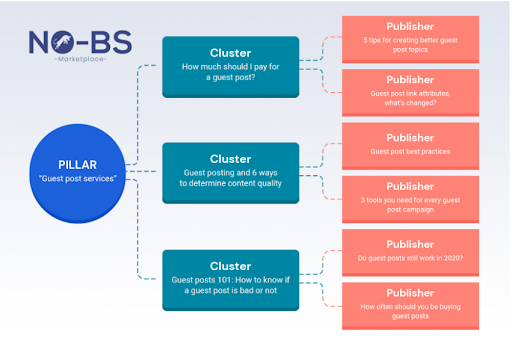
One cluster is ‘How much should I pay for a guest post?’
The two pieces of content that branch off of that cluster are ‘5 tips for creating better guest post topics’ and Guest post link attributes, what’s changed?’
So, you see that staying in your lane won’t stifle your creativity – especially if you choose the pillar & cluster model.
If you create multiple pieces of content that relate to one another, it’s important to include links. Internal links keep users on your website and show them you have a lot to offer within a specific topic. Let’s learn more.
- Internal Linking
Let the link juice flow! Link juice is link value. A link’s value measures how much traffic is being passed from one page to another. Let me explain:
- Page A has a link to Page B
- Page A is informative and has high traffic
- Page B is informative and related to page A
- Page B has low traffic
- By putting a link to Page B on Page A, users are directed to stay on your site to learn more.
This is an example of internal linking.
Simply put, internal linking is placing links within content or on a page that direct users to another part of your website. Internal linking is a way to keep users on your site by showing them that you have a lot to offer within your chosen niche.
- The Final Step – Fine-Tuning the Technical SEO
After you’ve created informative, useful, engaging, and fully optimized content, it’s time to add the finishing touches. When your content shows up on SERPs there are 3 details to keep in mind: Title Tag, Meta Description, and Link URL.
- Title Tag
The title tag is the title that appears in a google search. This can be the same as or different from the headline of the article or page. In the example below for a search for the ‘best beaches in the world,’ you can see the title tag for this search result is ‘The 50 Best Beaches In The World 2021 – Big 7 Travel.’
When crafting a title tag:
- Make sure it is around 60 characters or less
- Be mindful of keyword stuffing
- Place target keywords near the beginning
- Clearly represent what the content is about
- Meta Description
The meta description is the short blurb that appears below the title tag. This is often a huge factor in the click-through rate. The meta description should give a clear overview and stand out from other pages that are ranking for the same search query. You can see in the example below that the exact string of words used in the search were found directly in the meta description.
When crafting a meta description:
- Use no more than 160 characters
- Give a clear and concise overview of the content
- Include long-tail keywords if you can
- Link URL
Customize your URL to something that is easy to read and ideally concise. The URL for the 50 Best Beaches article is almost identical to the title tag.
Keep it Fresh
Once you’ve created high-quality content that is search engine optimized, you just need to maintain it. Search engines value updated and refreshed content over older or stale content. So, update and edit content when necessary and retire old or duplicate content every now and then.
Don’t feel pressure to make minor updates to all of your content all of the time. Instead, just get into the habit of reviewing existing content and updating it with new links or fresh information. If after reviewing you find that the content is a bit outdated, simply archive it or remove it from your site another way.
It can be time-consuming to audit your site and execute new SEO strategies. So, we created our wholesale SEO packages to save you time and money. Our team is here to help you through all stages of your SEO journey.
Conclusion
It’s clear that content is an important part of SEO. Content within an article or webpage, and the content that shows up on SERPs all play a role in how high a webpage ranks.
Optimizing content to improve rankings on SERPs takes time, research, and consistent action. But, it’s possible!
So, if you’re at the beginning of your journey with understanding Google’s algorithms and creating optimized content, this is your encouragement to keep going.
Subscribe to Our Blog
Stay up to date with the latest marketing, sales, service tips and news.




